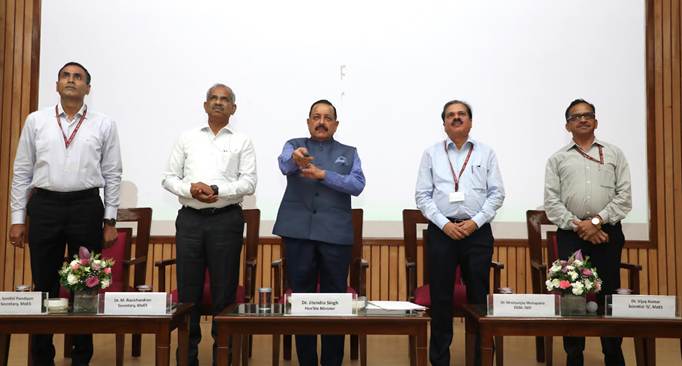In a boost to India’s climate resilience and public scientific engagement, Union Minister Dr. Jitendra Singh unveiled 14 cutting-edge scientific tools and citizen-focused digital services developed by the Ministry of Earth Sciences (MoES) on the occasion of its 19th Foundation Day on Monday. Addressing a gathering in the national capital, Singh highlighted the Ministry’s transformation over the last decade into a proactive, citizen-centric institution that delivers real-time, life-impacting services.
Calling science and innovation crucial for both sustainability and India’s economic aspirations, the Minister said, “We are now at a stage where even a casual user can access live weather alerts, cyclone warnings, air quality updates, and ocean forecasts on their mobile phones. This is the result of a government working in mission mode and a Ministry that has aligned itself with citizen services.”
Among the major initiatives launched were the Bharat Forecast System – Extended Range Prediction (BharatFS-ERP), high-resolution rainfall datasets, seismic microzonation studies, and marine biodiversity reports. Updated seabed charts, wave atlases, air quality forecasting models, rainfall monitoring tools, and crop-weather calendars were also released, along with a documentary titled Life Saving Impact by the India Meteorological Department (IMD).
Singh praised the Ministry’s remarkable progress in early warning systems. The number of Doppler weather radars has grown from 15 to 41 over the last ten years, while weather and seismic monitoring networks have also expanded significantly. “Now, within 2–3 minutes of an earthquake, lakhs of people can access alerts online,” he said, noting that demand was so high during a recent tremor in Delhi that it temporarily overwhelmed government servers.
Emphasizing the life-saving importance of improved cyclone forecasting, he recalled the tragic loss of 10,000 lives in Odisha during the 1999 super cyclone. “Thanks to better alerts, recent cyclones have been managed with minimal casualties,” he added.
The Minister also spotlighted the Ministry’s role in agriculture and fisheries. Over 7 lakh farmers use the Meghdoot mobile app to receive location-specific agro-advisories, while daily SMS alerts guide fishermen to safe and fuel-efficient fishing zones along the coasts.
Singh urged greater outreach to raise awareness about these tools, noting that many citizens remain unaware of the services available. “We must communicate in the language the common people understand,” he said, calling for coordinated messaging through other ministries and government platforms.
He also highlighted India’s strides in ocean-based sustainability, pointing to six Ocean Thermal Energy Conversion (OTEC) desalination plants in Lakshadweep, which now provide 1.5 lakh litres of potable water daily. “These islands, surrounded by sea, had no access to fresh water for centuries. Now they are water-sufficient,” he noted.
Singh described the Deep Ocean Mission as a potential economic game-changer. “Just as we will send one Indian into space through Gaganyaan, we may soon see an Indian dive 6 km under the sea with Samudrayaan. One up, one down—that’s the vision,” he remarked.
He also noted a near tripling of the Ministry’s budget – from ₹1,281 crore in 2014 to ₹3,658 crore in 2024 – enabling groundbreaking research and technological advancement. The Minister credited this growth to the unwavering support of the current government.
The event saw the participation of senior officials including MoES Secretary Dr. M. Ravichandran, IMD Director General Dr. Mrutyunjay Mahapatra, Joint Secretary D. Senthil Pandiyan, and Programme Head Dr. Vijay Kumar. Prof. Dev Niyogi, UNESCO Chair at the University of Texas, joined the celebrations virtually as Guest of Honour.










